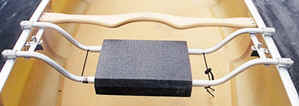I am building in the final stages of construction of a stitch and glue canoe (Free plans available from http://www.boatplans.dk/boatplans/boats ... ype=canoes) If you go to that link I am building the daytripper but also have the plans for the slated seats used in the touring version. Some early construction on the boat can be viewed at: http://www.boat.errington.org
Here it is waiting for the inside joints to be taped.

The problems I am having are due to the plans not indicating how to build the seat mounts or how to figure out how to locate the seats. I wish to be able to use the canoe for solo, tandem, and tandem with a seated passenger. Boat length is 15' 4", beam is 35", 4 chined, flat bottom. I really would prefer to make the slatted seats that are used for the touring canoe but need to figure out how to mount them. It looks like from the pictures that the slatted seats are mounted on regular seat frames and mounts.
Here is what I need to figure out.
1. If I go with regular seats I want to make webbed seats so need basic frame information such as wood dimension and seat area for comfort.
2. I am building inwales (3/8 cedar strips laminated to 3/8 x 3inch stand offs), but not sure they will be strong enough to support my weight. (about 235) and thinking side mounted rails would be stronger, perhaps even a center seat support to take some weight off the rails. These supports should be able to take either a webbed seat or the slatted seat design interchangeably
3. Rear seat position I expect will be fixed position from what I've seen. How high from deck to mount? how far forward to mount? When tandem paddling the forward paddler is expected to be much lighter in most cases.
4. Center seat should be flexable from taking any kind of seat and perhaps a sliding seat mount so I can balance it when solo or with a passeger
5. Forward seat same deal either seat type and sliding mount. Front paddler is mostly expected to be much lighter than rear paddler when paddling tandem.
